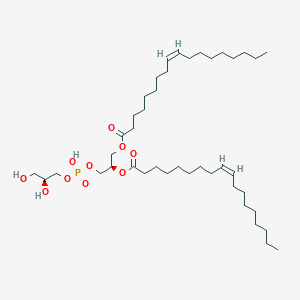PG(18:1(9Z)/18:1(9Z))
PG(18:1(9Z)/18:1(9Z)) is a lipid of Glycerophospholipids (GP) class. Pg(18:1(9z)/18:1(9z)) is associated with abnormalities such as Neonatal hemochromatosis, Renal tubular disorder, Hereditary pancreatitis and UDPglucose 4-epimerase deficiency disease. The involved functions are known as Genetic Translation Process, Regulation, Saturated, enzyme activity and Cytokinesis. Pg(18:1(9z)/18:1(9z)) often locates in Membrane, soluble, Tissue membrane, membrane fraction and Thylakoid Membrane. The associated genes with PG(18:1(9Z)/18:1(9Z)) are COIL gene, P4HTM gene, GRAP2 gene, Integral Membrane Proteins and synthetic peptide. The related lipids are Liposomes, Fatty Acids, Sphingolipids, DOPE and 1,2-oleoylphosphatidylcholine.
References related to lipids published in Others
| PMID | Journal | Published Date | Author | Title |
|---|---|---|---|---|
| 9922235 | J. Bacteriol. | 1999 | Hauge HH et al. | Membrane-mimicking entities induce structuring of the two-peptide bacteriocins plantaricin E/F and plantaricin J/K. |
| 17142391 | J. Bacteriol. | 2007 | Sun C et al. | Chloroplast SecA and Escherichia coli SecA have distinct lipid and signal peptide preferences. |
| 18583535 | Plant Physiol. | 2008 | Esseling-Ozdoba A et al. | Synthetic lipid (DOPG) vesicles accumulate in the cell plate region but do not fuse. |
| 23576726 | Proc. Natl. Acad. Sci. U.S.A. | 2013 | Last NB and Miranker AD | Common mechanism unites membrane poration by amyloid and antimicrobial peptides. |
